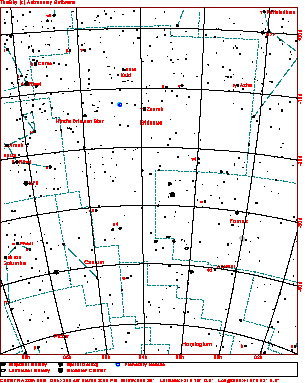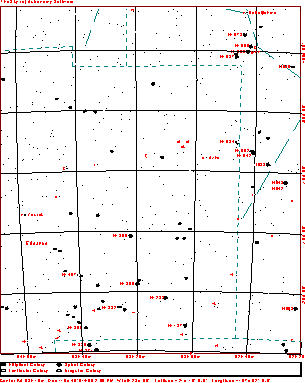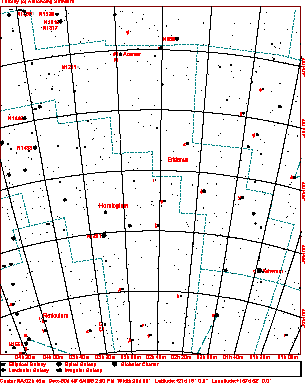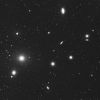
| Home | Deepsky Atlas | TheAstronews | Links | Solar System | ||||||

Hawaiian Astronomical SocietyConstellations: Eridanus -- The River claimed by Everyone |
||||||||||

Click the map for a 909x1149 version of the above. Click here for a map better suited for use in the field.

Click the map for a 909x1149 version of the above. Click here for a map better suited for use in the field.
Click here for a map better suited for use in the field.

Click here for a map better suited for use in the field.

Click here for a map better suited for use in the field.

Click here for a map better suited for use in the field.
 3k JPEG NGC1535 (Bennett 22, Best 52) is a planetary nebula described as very bright, small, and round. The middle is fairly small, and very abruptly brighter. Overall, Dreyer states the nebula is resolvable, but mottled. Steve Coe observed with a 13" under good conditions and found the central star easy. He was also able to distinguish the inner and fainter outer gas shell. The central star and the outer shell are not visible in an 8". It sits 4° ENE of Zaurak (Gamma Eridani). Image is a composite of four exposures taken with an SBIG ST-6 on a 24" Ritchey-Chretien by Richard Colman and David H. Spiers. 3k JPEG NGC1535 (Bennett 22, Best 52) is a planetary nebula described as very bright, small, and round. The middle is fairly small, and very abruptly brighter. Overall, Dreyer states the nebula is resolvable, but mottled. Steve Coe observed with a 13" under good conditions and found the central star easy. He was also able to distinguish the inner and fainter outer gas shell. The central star and the outer shell are not visible in an 8". It sits 4° ENE of Zaurak (Gamma Eridani). Image is a composite of four exposures taken with an SBIG ST-6 on a 24" Ritchey-Chretien by Richard Colman and David H. Spiers.
|
 106k JPEG NGC1399 (Bennett 19) is the brightest and largest of a host of galaxies in this image that spans the border of Fornax and Eridanus. Dreyer calls this elliptical very bright (mag. 9.8), fairly large (3'x3'), with a pronounced core. He also calls it very resolvable!? Perhaps he refers to a foreground star that sits 20" north of the nucleus. 1399 sits in the far left (east) of the photograph. Just below it (and accross the border in Eridanus) lies NGC1404 (Bennett 20 at mag. 10.9). The galaxy pair NGCs 1387 (mag. 11.7) and 1379 (mag. 12), present also in the image below lies due west of NGC1399. Just below (south) lies NGC1389. Just above, lies the much elongated NGC1381 (mag. 12.6). To the far right lies the pair NGCs 1374 (mag. 12 and top) and 1375 (mag. 13 and bottom). At the top of the image lies the elongated NGC1380 (mag. 11). 106k JPEG NGC1399 (Bennett 19) is the brightest and largest of a host of galaxies in this image that spans the border of Fornax and Eridanus. Dreyer calls this elliptical very bright (mag. 9.8), fairly large (3'x3'), with a pronounced core. He also calls it very resolvable!? Perhaps he refers to a foreground star that sits 20" north of the nucleus. 1399 sits in the far left (east) of the photograph. Just below it (and accross the border in Eridanus) lies NGC1404 (Bennett 20 at mag. 10.9). The galaxy pair NGCs 1387 (mag. 11.7) and 1379 (mag. 12), present also in the image below lies due west of NGC1399. Just below (south) lies NGC1389. Just above, lies the much elongated NGC1381 (mag. 12.6). To the far right lies the pair NGCs 1374 (mag. 12 and top) and 1375 (mag. 13 and bottom). At the top of the image lies the elongated NGC1380 (mag. 11).
|
 43k JPEG NGC1291 (Bennett 12) is a barred spiral galaxy described as very bright (mag. 9.4), fairly large (9.7' x 8.1'), with a much brighter middle. A 12" should just show the oval shaped bar, surrounded by a faint ring. It sits 3.7° ESE of Acamar (Theta Eridani). Image from the Digital Sky Survey. 43k JPEG NGC1291 (Bennett 12) is a barred spiral galaxy described as very bright (mag. 9.4), fairly large (9.7' x 8.1'), with a much brighter middle. A 12" should just show the oval shaped bar, surrounded by a faint ring. It sits 3.7° ESE of Acamar (Theta Eridani). Image from the Digital Sky Survey.
|
Image on the left is a ten minute exposure by Jerry Mulchin. He used a 10" SCT, an SBIG ST-8 with AO-7 adaptive optics. Color image on the right is from a slightly larger telescope, the 8.2m VLT run by the European Southern Observatory.
|
If you have any questions about the Hawaiian Astronomical Society
please
(link requires javascript).